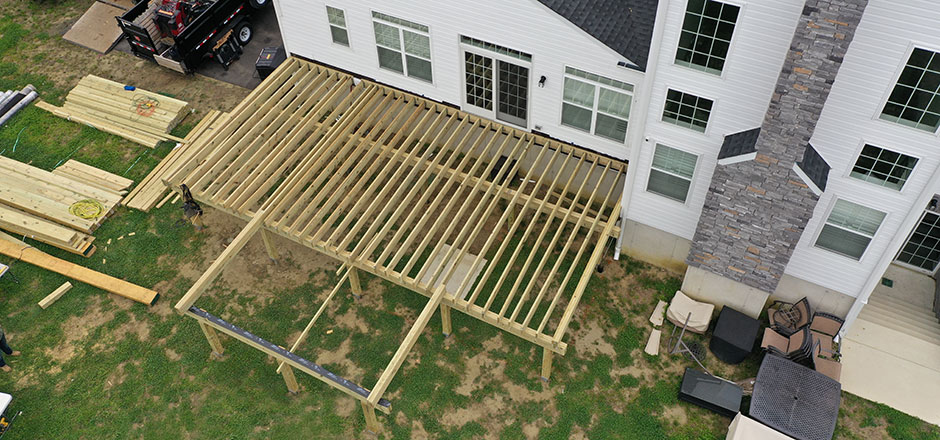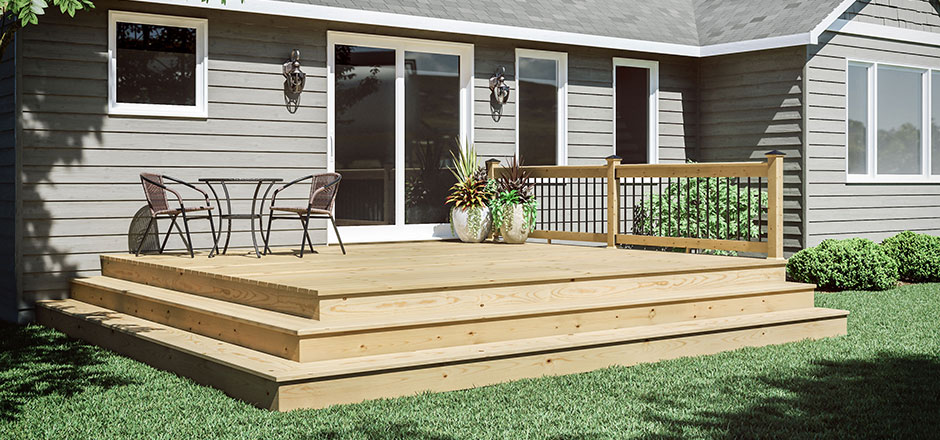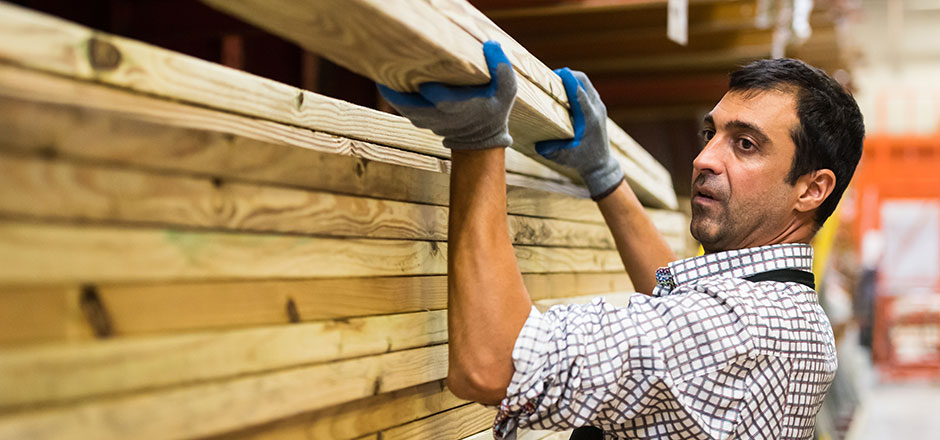Project Care & Handling
FOLLOW THESE TIPS WHEN WORKING WITH PROWOOD
Staining & Sealing
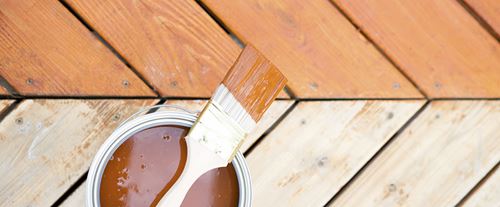 In some cases, ProWood treated lumber has water repellent already applied during the pressure-treating process. Make sure to read and understand the end tag on your new lumber to determine whether a factory-applied water repellent has been added. The information on the treated lumber tag or end tag will help you understand when to apply a topical wood sealer.
In some cases, ProWood treated lumber has water repellent already applied during the pressure-treating process. Make sure to read and understand the end tag on your new lumber to determine whether a factory-applied water repellent has been added. The information on the treated lumber tag or end tag will help you understand when to apply a topical wood sealer.
Stain or Seal Dry Wood
The time it takes for wood to dry out depends on the climate and the wood's exposure to the sun. During summer, pressure-treated lumber under full sun can dry in a few days. In cool, damp weather or when shaded, wood will take much longer to dry. Use the water test to see if it's time to seal (or re-seal). Drizzle some water onto the wood. If the water beads, the wood is still sealed and protected. If the water is quickly absorbed into the wood, it's time to apply a sealer. Test a few different areas of the surface. Note: High-traffic spots on a wood deck are likely to wear down before corners and railing balusters.
Sealing Kiln Dried Lumber
In some areas, you can buy treated wood that is Kiln Dried After Treatment (KDAT). With KDAT lumber, moisture is removed from the wood before shipment to a lumberyard. KDAT will be marked on each piece of wood with an end tag or an ink stamp. It is recommended that you seal KDAT lumber immediately unless it has been pressure-treated with a water-repellent additive.
Redwood & Cedar
Select ProWood products are constructed of natural cedar and redwood. Although both are naturally resistant to insects, rot, and decay, we recommend performing the following maintenance items:
- Clean the Select ProWood as shown above under ProWood.
- Seal the Select ProWood with a sealer made for exterior applications.
- Be aware when selecting a sealer that stain-tinted sealers will cover the natural beauty of the cedar or redwood.
- For best results, try to use a clear or light semi-transparent sealer product with a UV inhibitor, as cedar and redwood will fade to a grey patina over time.
- Repeat the process every 1-3 years as needed.
Add Color and Water Repellency with a Wood Sealer
Start by applying a topical sealant to your new project for surface protection. We do not recommend using a conventional multi-coat paint system or varnish. The performance is nearly always disappointing, and scraping and sanding often must precede repainting. Instead, choose an outdoor wood sealer. A wood sealer offers a degree of water repellency and color to treated lumber without forming a thick coating on the surface. It will also allow any remaining moisture to slowly leave the wood after the coating has been applied.Wood sealers come in three versions: solid stains, semi-transparent and clear.
- Solid Stains – It is recommended that "solid" wood sealers, which have more pigment, be used only on vertical projects such as fences and siding. If used on decking, weather and foot traffic will wear through the pigment unevenly.
- Semi-transparent Sealants – This type of wood sealant is suitable for vertical or horizontal surfaces such as deck boards, rails, siding, and playground equipment. There are several brands available in many colors.
- Clear Sealants – This type of sealant has no pigment or color. It still offers some protection from the weather, although wood fading will occur more rapidly than color with sealants. Eventually, the wood will fade to gray, which may or may not be the look you desire.
NOTE: We recommend using wood sealers that contain an ultraviolet stabilizer. The stabilizer will not prevent eventual discoloration to a weathered gray appearance, but it will slow the process down. Whatever sealant you choose, follow the manufacturer's instructions carefully.
CAN I PAINT IT?
While ProWood provides a surface that is easy to paint, we do not recommend painting it. However, if your decorative decisions call for paint, make sure the wood is dry before application. (Pour some water over the surface. Remember, if it beads, wait; if it is quickly absorbed into the wood, it's ready.)
MAINTENANCE
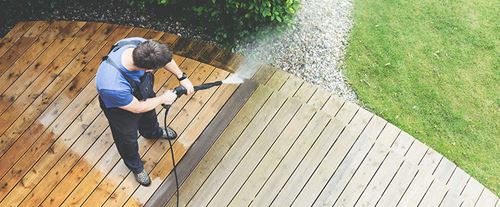 Apply cleaner/brightener every one to three years, depending on the appearance of the outdoor project, followed by a coat of sealer to rejuvenate the color of the wood.
Apply cleaner/brightener every one to three years, depending on the appearance of the outdoor project, followed by a coat of sealer to rejuvenate the color of the wood.
If you decide to wait more than three years to perform your next cleaning, you may want to use a power washer as your first step in the cleaning process.
To restore gray, weathered wood, use a power washer, then clean with a cleaner/brightener to help bring the wood back to its natural appearance. This prepares the wood for better penetration of a wood sealer. Work the brightener in with a stiff bristle brush, followed by a thorough rinsing with water. Take care to protect surrounding vegetation as some cleaners may damage them. Follow the cleaner container instructions closely.
After the wood is completely dry, apply a wood sealer. If the sealer you use is colored, be sure to use a comparable color or darker color than your original wood project.
The diagrams and instructions in this brochure are for illustrative purposes only and are not meant to replace a licensed professional. Any construction or use of the product must be in accordance with all local zoning and/or building codes. The consumer assumes all risks and liability associated with the construction or use of this product. The consumer or contractor should take all necessary steps to ensure the safety of everyone involved in the project, including, but not limited to, wearing the appropriate safety equipment. UFP Industries makes no warranty, either express or implied, and shall not be liable for any damages, including consequential damages.
Handling & Disposal
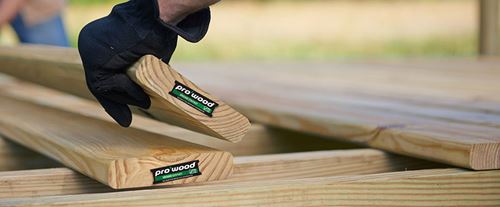 ProWood lumber and products are safe for people, animals, and the environment. ProWood is also a beautiful, safe option for planter boxes and garden beds. ProWood is a superior lumber product, but it's important to follow several tips when working with any treated wood, including ProWood lumber.
ProWood lumber and products are safe for people, animals, and the environment. ProWood is also a beautiful, safe option for planter boxes and garden beds. ProWood is a superior lumber product, but it's important to follow several tips when working with any treated wood, including ProWood lumber.
ProWood Handling Recommendations:
- Only use ProWood lumber that is visibly clean and free of surface residue for patios, decks, and walkways.
- Do not burn ProWood.
- Avoid prolonged inhalation of any sawdust.
- When sawing, sanding, or machining wood, wear a dust mask. When power-sawing and machining any wood product, wear goggles.
- Wear gloves.
- At the end of each work session, clean up and dispose of all sawdust and construction debris, wash exposed areas of your body thoroughly, and wash your work clothes separately from other household clothing.
ProWood uses which are not recommended include:
- Areas where ProWood may come into direct or indirect contact with drinking water, except incidental contact such as freshwater docks and bridges.
- Areas where ProWood may become a component of food, animal feed, or beehives.
- Mulch for gardens or farming.
ProWood Fastening Recommendations:
Things to remember when fastening ProWood MCA treated lumber:
- There's no need for special fasteners. Use hot-dip galvanized or other fasteners as recommended by building codes.
- Aluminum building products can be placed in direct contact with ProWood; however, aluminum contact is not recommended when ProWood products are immersed in water or are subject to frequent and prolonged wetting or other severe exposure conditions. In such cases, a moisture-resistant protective barrier should be placed between the aluminum products and ProWood.
ProWood FR Handling Recommendations:
- ProWood FR (Fire Retardant) wood must be stored off the ground and protected from weather to prevent loss of the protective chemical treatment. Likewise, exposure during construction should be minimized. If some exposure occurs, the material must be allowed to dry to its original specification before being covered or exposed.
- Do not burn fire-retardant-treated wood.
- Wear a NIOSH N95 dust mask and goggles when cutting or sanding wood.
- Wear gloves when working with wood.
- Some fire-retardant-treated wood chemicals may migrate from the treated wood into soil/water or may dislodge from the treated wood surface upon contact with skin. Wash exposed skin areas thoroughly.
- All sawdust and construction debris should be cleaned up and disposed of after construction.
- Wash work clothes separately from other household clothing before reuse.
- Fire-retardant treated wood should not be used where it may come into direct or indirect contact with drinking water.
- Do not use fire-retardant-treated wood under circumstances where it may become a component of food, animal feed, or beehives.
- Do not use fire-retardant-treated wood as mulch.
- Only fire-retardant-treated wood that is visibly clean and free of surface residue should be used.
FAQ
-
Should you paint your pressure-treated wood project?Although ProWood provides a surface that is easier for paints to cover, we do not recommend painting it. ProWood does not need protection from the elements. But if your decorative decisions call for paint, make sure the wood is dry before application. (Pour some water over the surface. If it beads, wait; if it seeps into the wood, it's ready to paint.)
-
After my project is built, is any special maintenance necessary?ProWood is designed to give professional-grade results that last. Left unfinished, it ages gracefully, eventually softening to an attractive driftwood gray. On flat surfaces such as decks, however, leaves and other debris may collect and create unsightly stains. Even if your lumber has the locked-in protection of factory-applied water repellent, you'll want to follow an annual maintenance program that includes a semi transparent stain or a sealant which contains an ultraviolet stabilizer. If you stain your project, a quality penetrating latex or oil base stain is recommended.
-
When is special handling required?
Our warranties outline specific handling tips.
The most important precaution is DO NOT BURN TREATED WOOD. When pressure-treated wood is burned, the preservative chemicals concentrate in the ash and may be inadvertently inhaled. Wear gloves when handling treated lumber, and always wear safety goggles and a dust mask when sawing or cutting treated lumber, just as you would with untreated lumber.
KEEP IN MIND:
Mold growth may occur on any surface. While ProWood has been treated to help resist fungal growth, nothing can entirely prevent mold. Should mold growth occur, remove it from ProWood by simply washing it away with soap and water.
ProWood Disposal Recommendations:
ProWood that is no longer usable — such as cutoffs, broken boards, sawdust, or any product that has been taken out of use — may be disposed of in landfills. It should not be burned in open fires, in stoves, in fireplaces, or in residential boilers. For California, check with the landfill to confirm disposal procedures are correct.
ProWood FR Disposal Recommendations:
- Fire-retardant treated wood may be disposed of in landfills or burned in commercial or industrial incinerators or boilers in accordance with federal, state, and local regulations.
- If you desire to apply paint, stain, clear water repellent, or other finish to your fire-retardant-treated wood, we recommend following the manufacturer’s instructions and label of the finishing product. Before you start, we recommend you apply the finishing product to a small exposed test area before completing the entire project to ensure it provides the intended result before proceeding.
- Projects should be designed and installed in accordance with federal, state, and local building codes and ordinances governing construction in your area and in accordance with the National Design Specifications (NDS) and the Wood Handbook.
- Mold growth can and does occur on the surface of many products, including untreated and fire-retardant-treated wood, during prolonged surface exposure to excessive moisture. To remove mold from the treated wood surface, the wood should be allowed to dry. Typically, mild soap and water can be used to remove the remaining surface mold. For more information, visit www.epa.gov.
- Use fire-retardant-treated wood safely. Always read the label and product information before use.
